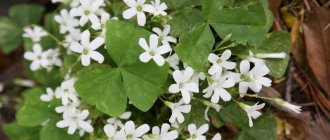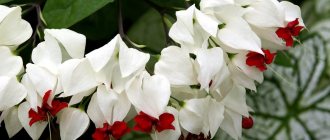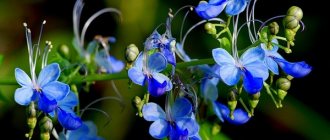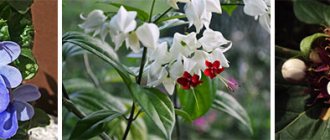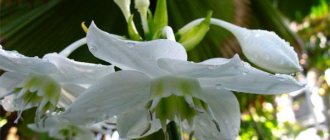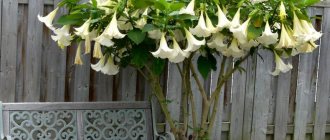Clerodendrum Thompson is a spectacular indoor plant, which is both an interior decoration and a good omen. The plant is popularly called “pure love”, as well as the “tree of fate”, and its appearance in the house marks good luck, happiness, and the beginning of good times for the whole family. Let's learn how to care for clerodendrum so that it grows well, develops, blooms and does not get sick.
Botanical description and history
Clerodendrum Thompson belongs to the Verbenovaceae class, deciduous flowers. The plant has a peculiar shape - the branches are woven in the form of vines. Clerodendrum originates from the tropics of Asia, South America and Africa. Many people use it to decorate parks and gardens, but the flower can be used as a houseplant.
In the wild, the shoots of the flower quickly become woody and can grow by 4 meters ; in a room they grow by 2 meters in a year. The leaves are painted in a bright green tone, have a heart-shaped shape, with pointed ends, and are located opposite on the stem. The leaf length can reach 15-20 cm.
Strongly pronounced veins on the leaf plane create the appearance of a quilted surface. The edges are either solid or jagged. Some plant varieties are more decorative due to their variegated foliage.
Bush formation
Gloriosa flower: home care and planting examples
Forming a bush is a very interesting procedure, and Thompson's clerodendrum is well suited for this. It can be grown as an ampel flower, or you can, for example, grow it around the perimeter that the plant owner himself wants. That is, you can make some kind of frame and grow along it, or around the room, or in any other shape.
Note! It is also possible to give it a racemose shape or a standard tree using formative pruning.
Photo
Here you can see how the flower looks in the photo:
How to propagate
Thompson's sclerodendron can be propagated from cuttings and seeds. Self-collected seeds germinate well and retain all the characteristics of the species. Sowing seeds is used less frequently due to the slow growth of seedlings.
Cuttings
Peculiarities. Planting of seedlings is carried out in spring or autumn at the same time as pruning. Spring is a more favorable time for rooting and beginning of growth. The easiest way to root Mrs. Thompson's clerodendrum is with green tip cuttings. For faster rooting, cover the container with the planted cuttings with foil or a plastic cup. Remove the lid daily, remove condensation and ventilate.
Algorithm of actions
- Using a sharp tool, trim the ends of the shoots with two or three internodes. The optimal length of cuttings is up to 6 cm.
- Prepare a substrate of sand, turf and humus.
- Place the cuttings vertically in moist soil.
- The soil is regularly moistened and the temperature is maintained at 22-25 °C.
Before planting, the cuttings can be placed in water with crushed activated carbon. After the roots appear, the cuttings can be planted in the soil. Handle them carefully - young dendrobium roots are very easy to damage.
Seeds
Peculiarities. This plant can be grown from seeds collected from your own plant. A favorable time for planting is spring. Seeds germinate quickly, even without prior soaking and the use of stimulants.
What to do
- Fill a shallow, wide container with a light potting mix.
- Spread the seeds on the surface and cover with a thin layer of soil.
- Moisten the soil with a spray bottle, then cover the container with clear plastic wrap.
- As soon as shoots appear, remove weak plants.
- At the stage of four true leaves, transplant into separate containers.
For rapid seed germination, as in the photo, it is necessary to maintain regular humidity and a temperature of at least 24°C. Despite good germination and relatively rapid development of seedlings, the first flowering occurs only after several years.
What kind of variety?
The plant has the following qualities:
- grows quickly;
- the stems quickly become woody;
- in winter the flower sheds its leaves;
- vines and various branches grow rapidly;
- the flowers are heart-shaped with bright red corollas.
Known varieties of the plant are After blooming and Albo marginata. The first is famous for the light purple color of the stipule, the second for the superiority of the light yellow tone over green.
Each of the representatives of clerodendrum is unique and beautiful in its own way. We invite you to familiarize yourself with information about such flower varieties as Ugandan, Philippine, most beautiful, brilliant, speciosum, inerma, Prospero, Wallicha and Bunge.
Actions after purchase
How to care for Mrs. Thompson's clerodendrum after purchase? The best way to quarantine them is to place them separately from other flowers. Quarantine is recommended for every plant you bring home. This helps to identify pests, diseases and avoid infecting other flowers.
To facilitate adaptation, place the clerodendrum in a well-lit but not sunny place. Water sparingly to keep the soil evenly moist but not soggy. Maintain temperature at 20°C. There is no need to feed during the first month after purchase.
The adaptation period ranges from one to two weeks, depending on the initial state of the plant. Once the clerodendron has acclimated, it can be replanted in suitable potting soil and returned to its original location.
Features of flowering
When and how does it bloom?
Because of its beautiful and long-lasting flowering, Clerodendrum Thompson has become a popular houseplant. Flowering begins from March to April and ends in September-October. In the buds of the leaves located on the side stems, buds appear that resemble clusters. They exude a pleasant and lasting scent. In total, the brush contains from 8 to 20 flowers.
White lantern-shaped bracts and a small scarlet corolla, from which yellow stamens up to 3 cm long grow, make the plant truly unique. The bract remains on the stem for 3-4 months, changing color to pink and then purple. The corolla quickly fades.
At the final stage of its flowering, the clerodendrum bush becomes similar to lilac , both in appearance and in the aroma it emits. A small orange fruit appears in the flower area, which has an oval shape up to 1 cm long. There is only one seed in the box.
Why doesn't this happen sometimes?
The plant will bloom beautifully, amaze you with its unusual shape and brightness of the buds, if you follow all the standards for caring for it. In some situations, flowering does not occur and the stem is not covered with inflorescences. This happens due to the following reasons:
- improper care in the winter season;
- lack of sunlight;
- lack of nutrients in the soil.
All these factors can be corrected. It is important to remember that the flower is prepared for wintering in the fall, when the growth period of the vines ends. The period of fertilization and watering are interrupted. The pot with clerodendrum is moved to a cool area where the temperature is in the range of 10 to 16 degrees.
The shoot may lose its flow, but this is not dangerous for the flower. It survives the winter and will be covered in leaves and flowers again in the spring. When the day begins to grow, it is necessary to resume fertilizing and watering so that the plant does not die.
Clerodendrum will be saved from a lack of solar heat by daily illumination for several hours. And if there is a lack of nutrients in the soil, it is recommended to make special additions for indoor plants every 2 weeks.
How to make it bloom?
The lush flowering of the plant depends on compliance with the standards that clerodendrum requires for proper development. A gardener needs to know how to water a plant properly, maintain the required humidity, and choose the right soil and pot.
The temperature in the room and the location of the flower itself are also important. Do not forget about pruning, which ensures the development of new shoots. In addition, the condition of the plant in the winter season will play a big role. It is during this stage that the clerodendrum is restored and gains strength for the next year.
Attention! The lack of a warm winter can have a bad effect on the condition of the flower and the subsequent setting of buds. High temperature and lack of sunlight also negatively affect the development of the plant.
Why does Thompson's clerodendrum not bloom?
Clerodendrum may not bloom because it does not have enough light, nutrients and water. In general, artificial conditions are not so close to natural ones. Therefore, you need to monitor vital characteristics for clerodendrum. You can also carry out the following operation: after the crown has formed (somewhere in February), you need to leave the shoots (about 60 cm in length), and cut off the leaves. At the end of March - beginning of April the first flowers will appear. But for this procedure the plant must be an adult.
Lush green flower
Clerodendrum Thompson needs to arrange conditions that are as close to natural as possible in order to obtain flowering and proper flower development. However, this will not require a lot of time and effort. Clerodendrum Thomsoniae is an interesting, not very fussy plant that is easy to care for and will delight the residents of the house with its appearance.
Caring for a plant at home
Landing
Thompson's clerodendrum needs to be planted in late February - early March. It is at this time that it is full of strength for development and flowering. The plant needs diffused but bright light. The best place for it will be the window sill of the western and eastern windows.
In addition, you need to organize a little shading so that sunlight does not burn the flowers that are just starting to grow. If the plant is located in the northern part, then it most likely will not bloom due to a lack of sunlight.
Requirements for soil, pot, habitat, lighting
To grow a flower you need slightly acidic and permeable soil. It is recommended to use already prepared substrate for houseplants.
In order to mix the soil yourself, you will need the following ingredients:
- leaf soil - 2 parts;
- coconut fiber – 1 part;
- sand - 1 part.
At the bottom of the pot you need to place drainage - ground brick, expanded clay or small crushed stone. Drainage protects the flower from the effects of moisture. The desiccant layer should reach one fifth of the pot. The plant does not tolerate direct sunlight and strong gusts of wind.
Requirements for humidity, watering, fertilizing
During development and flowering, clerodendrum needs constant moisture. It is recommended to water the plant when the top layer of soil is dry. There is no need to overwater the flower or keep it in a dry environment.
During winter, watering should be done carefully, as the plant is dormant. At low temperatures, the flower will slowly absorb water, so the soil dries out after a long time. Before watering, you need to let the water sit at room temperature.
In addition to soil moisture, air humidity must be observed. To do this, you need to spray the clerodendrum from a spray bottle.
During the growing season, you should constantly feed the plant with complex fertilizer once a week. When autumn comes, it is necessary to switch to a monthly fertilizing system; during winter, fertilizing stops.
Is pruning or pinching necessary?
When the flower develops into an adult plant, it becomes necessary to prune it. This process helps give the clerodendrum a certain shape and stimulates it to bloom for a long time. It is recommended to prune it in the spring. The shoots and vines are shortened by about a third. Before you start pruning, you need to remove broken and diseased branches of the plant.
Young flowers do not need to be pruned , but it is recommended to pinch the top of the stem. This will allow it to branch more.
When the plant has bloomed for the second time in a season, you need to cut off all the flower stalks. Approximately at the same time, fertilizing stops. This way the plant will be as ready as possible for the winter.
In addition to pruning, it is necessary to constantly pluck out the young root shoots that appear at the base of the stem.
Propagation by cuttings
There are two ways to propagate a plant - seeds and cuttings. The first method does not cause difficulties, while the second may cause problems.
This is what will be discussed in more detail. The cutting process is carried out after spring pruning. At this time, only shoots suitable for planting remain. A suitable cutting should have 3-4 internodes. You can root the shoots either in water or directly in the soil.
The procedure must be performed following the following instructions.
- The stem needs to be planted in a small cup, which must be filled with loose, nutritious and moist soil.
- The cutting must be covered with a plastic bag. This will create a small greenhouse that will provide all the conditions for the flower.
- After this, the glass is placed in a bright area.
- The seedling should be ventilated by lifting the coverings. You also need to water the cuttings.
After two months, the cuttings take root. This will be evidenced by small leaves appearing on the shoot. After this, you can transplant the flower into a flowerbed or pot.
How to form a bush?
The correct shape of the bush is achieved by trimming excess, rotten or broken branches. It is necessary to know exactly what size the flower should be so as not to cut off unnecessary parts of the plant. In addition, when forming a bush, you should carefully cut off the shoots, as you can accidentally cut off the buds or damage the trunk.
Reproduction
The shoots of the plant tend to quickly become woody. To propagate Thompson's clerodendrum, young, still herbaceous stems are used.
Each cutting should have 2-3 internodes and be at least 5-6 cm.
takes root well, and you can even form roots in a glass of water.
If you have the time and desire, try propagating clerodendum with seeds, but then the young plants will have to wait much longer for flowering.
Difficulties, problems, diseases, pests
This plant needs careful supervision, as it reacts very painfully to care errors. When growing clerodendrum, such problems may arise.
- Falling leaves . This may be caused by poor soil moisture, poor soil or insufficient air humidification. To prevent the leaves from falling off, you need to think about caring for the plant.
- The appearance of yellow or brown marks . The appearance of such spots indicates a sunburn. It is necessary to remove the plant in partial shade.
- The appearance of insects . This will be evidenced by cobwebs on the leaves and their wilting. To remove insects, you need to rinse the stem in the shower. Damaged elements of the flower must be removed, and the plant itself must be treated with special insect repellents.
Clerodendrum is easy to grow; with its bright appearance it will decorate any room, creating an atmosphere of coziness and comfort. You just need to follow the rules of care and provide the flower with proper care.
Replanting, pruning
The transplant is carried out in February or March, even before the start of active growth. Young specimens are transplanted annually into containers with a larger diameter. Adult specimens need to be transplanted into the same pots with partial replacement of the substrate and pruning of the roots approximately every 3 years.
But regular and deep pruning is absolutely necessary for adult clerodendrums. When is the best time to prune Thompson's clerodendrum? This should be done in early spring. The stems are shortened by 1/3 of the length, thereby provoking the active growth of lateral branches. In young plants, simply pinch off the tips.

